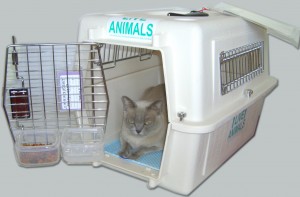 |
One of the most important thing you can do for your pets when preparing for long car trips or travel on an airplane is to get them used to spending time in their crate. You can do this at any age even old dogs can learn news tricks. Acclimating your pet to his or her crate is much like crate training a puppy with a few twists. |
Dogs
-
-
- Introduction: The first step for acclimating your dog to his / her kennel crate is to let your dog explore the crate by placing nice things inside. Favorite blanket or bed, yummiest treats and funnest toys. Be sure and tie the door in open position or remove the door all together for the first few days. If your dog is still unsure of going in or is feeling stressed or suspicious take the top of the kennel off and just use the bottom portion for a few days. Remember it has to be his or her idea do not force them in and do not lock them in once they go in willingly or with a little coaxing. Also be sure and place the kennel crate in an area your pet enjoys most like in the living room, den or bedroom, not in a room your pet avoids like the laundry room or basement where furnace or washer and dryer noises may spook an already guarded pet.
- Increase Time: The next step, once your pet is going in and out of kennel willingly and seems to rest inside, is to slowly close the door and allow your dog to take short naps in the crate. Start with a few minutes at a time then slowly increase the time in 15 minute increments.
- Reward Training: Now that your dog is used to being crated and seems to enjoy time in the crate it is time to “test the waters”. Load your pet in the car for a few short rides in the kennel crate. Have someone else drive so you are available to assure your pet. Be sure to remove all the toys and treats for this part, bedding or blankets are fine. Each time you return home reward your pet with praise and yummy treats. Make a big deal out of it make him feel he accomplished something very important and special.
- Flight Simulator: Last comes the big test… Take your dog for another car ride in his / her crate make sure the crate is securely closed, try rolling the windows down on the highway or make a trip to an unfamiliar environment, like to the landing and take off viewing area surrounding an airport or even better through an old fashion car wash. Again, be sure to have someone else drive so you are there to re-assure and monitor your pet. This will be a true test to see how your dog responds to loud noises, stress and possible startling while being crated. The inside of the car wash is a perfect test it is loud with lots of moving air noises, bumping, thrashing, dark, and a little stuffy. This is a great way to do a mini test run for what your pet will experience during take offs and landings. The only difference is your will be with your pet and be able to comfort and reassure him. Make sure and bring treats with you so you can reward your dog as soon as this is over and make a big deal out of it, similar to the first time your dog sat or fetched. Remember this is just like teaching your pet a new trick.
Cats
-
- Introduction: Cats are much easier to to get to go into a crate. For them I suggest leaving the crate with the door open or removed and place it in a room your cat enjoys and ignore it. Be sure to place a nice bed or blanket in it or even some fresh catnip. Cats are normally curious and they love to climb into things to play, explore or hide when startled. Leave it there for a good week or two. If you do not see your cat in the crate or are just not sure if he is indeed going into it, leave a few of his favorite snacks in it and check later to see if they are gone.
- If your cat is still not spending time in it you can camouflage the crate by draping a small blanket over it just leaving the doorway exposed.
- Once your cat is spending time in the crate, you can follow the directions above for Reward Training and Flight Simulator although cats are not as easy to bribe with treats as dogs. One important note is to always line your cat crate with plenty of absorbent material I recommend DryFur pads, especially during any long car rides or flight simulating. Your cat will be forever afraid of her crate if she has an accident in the crate and is forced to ride all the way home to get dry and clean.

